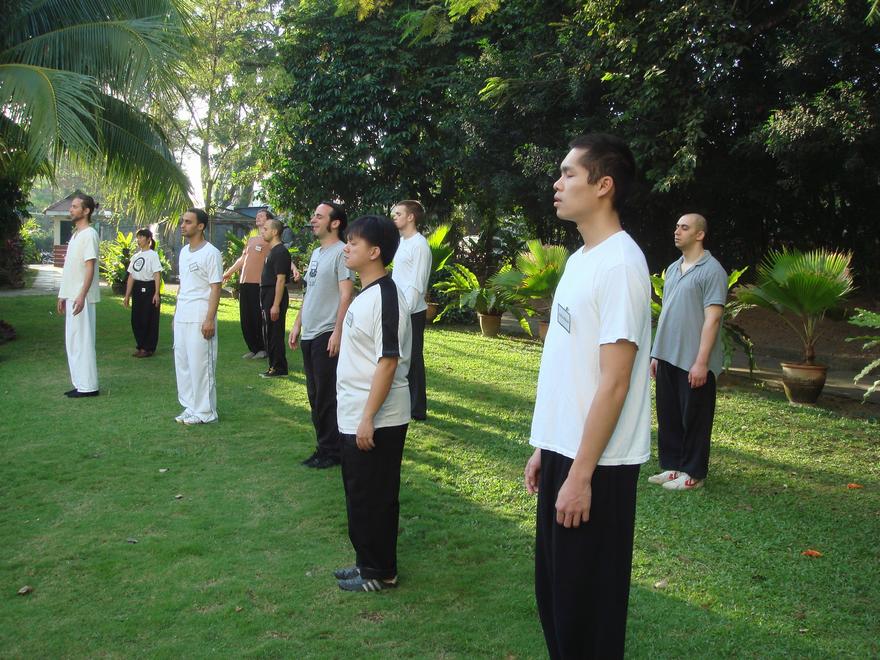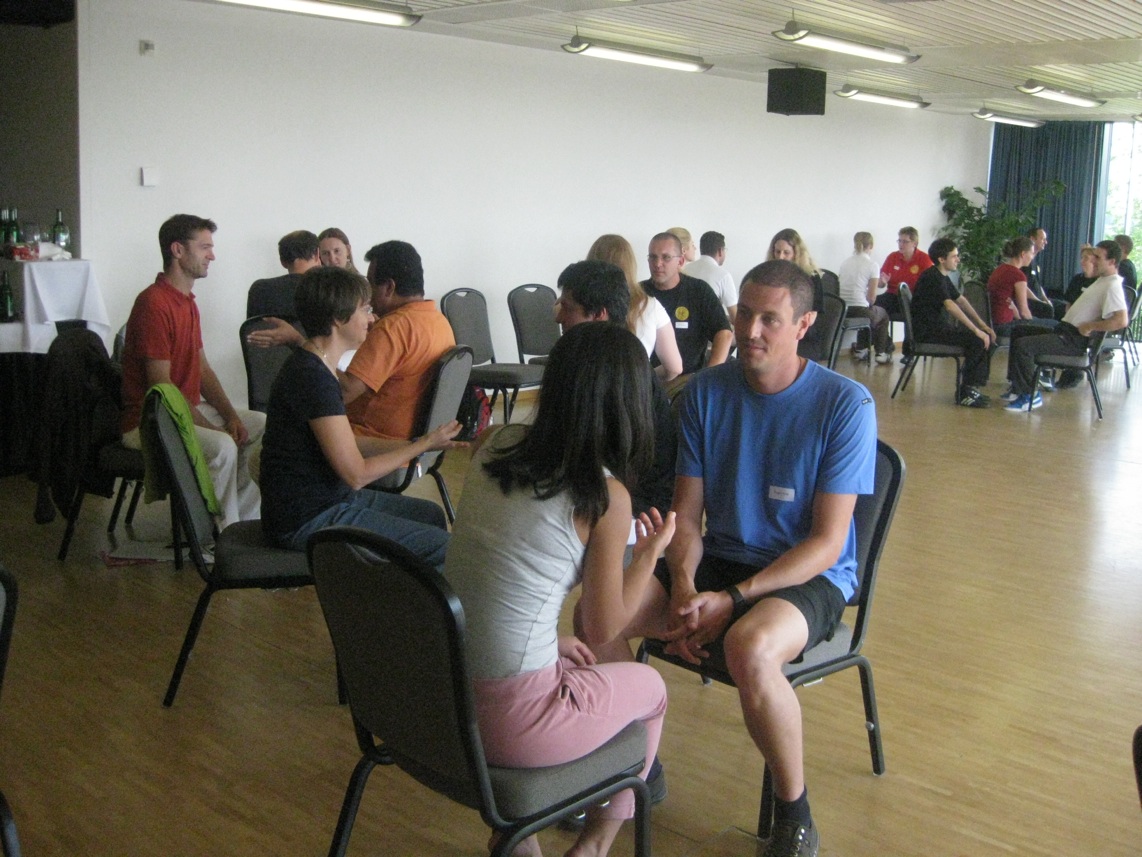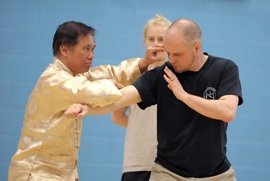THREE DIMENSIONS OF MIND TRAINING

Attaining a one-pointed mind
Question
Could you please tell us about the three dimensions of mind training in Zen?
Could you please elaborate them?
You told us that the great Zen and Shaolin patriarch Bodhidharma put emphasis on the so called sudden approach. Enlightenment can be achieved in the here and now. How could we possibly transfer this approach into for instance our own Chi Kung training?
Could it be that with our high level Chi Kung which is a legacy of the Great Bodhidharma for example blockages even deep rooted once just get cleared suddenly? Could this approach also lead to the fact that our Kung Fu students achieve for example in a one day force training course in Zhan Zhuang as much as many other martial artists maybe in ten years?
Sifu Roland Mastel
Answer
There are two dimensions in Zen training, the mundane dimension and the supra-mundane dimension.
The mundane dimension concerns our phenomenal world. The supra-mundane dimension concerns transcendental Cosmic Reality.
Zen training gives us the best in either dimension. In the mundane dimension, Zen trains the mind to achieve the best result in whatever we do in our daily life. In the supra-mundane dimension, Zen training brings us the highest attainment any being can achieve, called differently due to difference of culture, such as Enlightenment, Buddhahood, returning to God the Holy Spirit, union with God, and merging with the Great Void.
In the phenomenal realm, the three dimensions of mind training in Zen are to tame the mind, to strengthen the mind, and to expand the mind.
For the great majority of people, the mind is described as horses and monkeys, i.e. people continuously affected by ceaseless thoughts. Thus, the first task is to tame the mind. There are many methods to do so, but all the methods can be reduced to one or zero.
In the one-approach, the principle is to use one thought to represent hundreds of thoughts. A practitioner focuses on one thought, which can be an object, an idea or a simple process. He may, for example, focus on a spot in front of him or his dan tian. He may focus on counting from 1 to 4 and repeat the counting, or foucs on his breathing. He may focus on his simple movement like Lifting the Sky or a Shaolin or Taijiquan pattern. Once he can focus on one thought, which must be done gently, all other thoughts will be kept away.
In the zero-approach, he keeps his mind free from all thoughts. My sifu, Sifu Ho Fatt Nam, taught me an effective method. Just keep the mind empty, and whenever any thoughts appear, just throw them away. It is simple, but not easy. It needs much mind power to do it successfully. Another method is to imagine yourself to be a burning cauldron. Any thoughts that enter your mind will be burn away (but your mind is cool and fresh despite the burning fire).
The one-approach is easier than the zero-approach. The aim of the one-approach is to attain a one-pointed mind, whereas that of the zero-approach is to expand into the Cosmos where practitioners can tap into universal wisdom and inspiration.
The one-approach and the zero-approach are also used in the supra-mundane dimension. The methods are the same, but the attainments are different. The onus of the mundane dimension is peak performance, whereas that of the supra-mundane dimension is the highest spiritual fulfillment.
These two approaches are used in all spiritual and religions disciples, though they may not be well defined. It is necessary to attain a reasonably high level in being one-pointed before practitioners can expand into zero. In other words, if practitioners’ mind is distracted by thoughts, he cannot merge with the Cosmos.
These two approaches are well defined in the Buddhist tradition. Attaining a one-pointed mind is focused in Sammadha or concentration meditation, and expanding into the Cosmos is focused in vispasaana or wisdom meditation. In sammadha meditation, practitioners’ mind is concentrated; in vispassnna meditation, practitioners attain cosmic wisdom.
In any religion, chanting prayers and worshipping God or gods are effective means to attain a one-pointed mind. When the mind is one-pointed, it expands beyond the physical body and merges with the Cosmos, described differently in different culture as seeing God, merging with Tao or attaining a satori.
Although we do not practice meditation in a seated lotus position, our students have attained incredibly high levels in concentration meditation and wisdom meditation. Indeed, attaining a one-pointed mind is a basic requirement in our school, without which a student would be unable to practice chi kung or develop internal force. It is precisely because most other chi kung and kungfu practitioners are unable to attain a one-pointed mind that they have no chi kung benefits or fail to develop internal force despite having the right techniques.

Applying the Zen mind in the mundane dimension
Of course, attaining a one-pointed mind which together with being relaxed constitute a chi kung state of mind, is not just for practicing chi kung and developing internal force. It enhances every aspect of our daily life.
There are three stages of mind training -- taming the mind, strengthening the mind, and expanding the mind. For most other people, the middle stage, i.e. strengthening the mind, is not well defined. It occurs haphazardly. When others can tame their mind, they do not waste energy on ceaseless, irrelevant thoughts.
But in our case, we strengthen our mind purposely and systematically. The Zen course is special for this purpose. In advanced methods like Cosmic Shower and Cosmic Breathing, we let cosmic energy strengthen us not only physically, but also emotionally, mentally and spiritually. These emotional, mental and spiritual dimensions constitute our mind.
Even if you have not taken these advanced courses but by just practicing our basic exercises, you will also have strengthened your mind. You are not just your physical body. You are an integrated unity of the physical body, energy and mind. Some cultures call the mind, the spirit, soul or consciousness.
Energy is the link between the physical body and the mind. When we train energy, we strengthen our body and our mind. Hence, chi kung is sometimes called triple cultivation – it cultivates the body, the energy and the mind.
Other people may ask, “How do you know you have strengthened your mind?” We don’t ask such a question because we know from direct experience, just as we don’t ask how we know we have a chi flow or have developed internal force. In principle, it is like asking how does one know he is sitting on a chair or using a computer. He knows it when he sits on a chair or use a computer. Of course, sitting on a chair and using a computer (in today’s age) are commonplace, but strengthening the mind, enjoying a chi flow and developing internal force are elite.
Yet, it may be useful for confirmation, especially for those who are still new in the practice, to assess whether we have strengthened our mind, i.e. whether we have strengthened ourselves emotionally, mentally and spiritually.
If, for example, you were nervous or afraid, but after practicing our arts you are calm and confident, then you have strengthened yourself emotionally. If previously your thoughts controlled you, but now you control your thoughts, then you have strengthened yourself mentally. If previously you were depressed and disorientated, but now you are happy and peaceful, then you have strengthened yourself spiritually.
Zen is famous for its sudden approach, i.e. attain Enlightenment in an instant. It is also in records that Zen has had the biggest number of people who attained Enlightenment. In other religions and spiritual disciplines it took years or lifetimes to attain the highest spiritual fulfillment, and that only happened to masters.
We can transfer this sudden approach into our chi kung, kungfu and all aspects of our life by following the spirit of Zen, which is to be simple, direct and effective. This, in fact, is characteristic of our school, enabling us to have remarkable results in a very short time.
When we want to generate a chi flow or develop internal force, for example, the techniques we use are very simple. In fact some students later reported that initially they wondered whether these simple techniques worked. We perform the techniques directly, like Lifting the Sky or Horse-Riding Stance. We did not bother with frills and decorations. Our practice give us the desired benefits effectively, often immediately after the exercise. We do not have to wait for a year or two to see results.
In daily life, if you want to buy a shirt or take your girlfriend out for a date, you carry out your task simply, directly and effective. You buy a shirt or take your girlfriend out for a date. You don’t spend a week going round many shops to find the best bargain or spend a lot of time how and when to ask your girlfriend.
You buy a shirt or take your girlfriend out directly. You don’t ask a shop assistant to show you some shoes, ties or handbags first. You don’t ask your girlfriend what food she likes, where she spent her last holidays, or whom she met at her office. You accomplish your task effectively, i.e. you have bought a shirt or taken your girlfriend out.
Our high level chi kung, like other legacies of Bodhdharma, is simple, direct and effective. But it may or may not clear deep rooted blockages suddenly. Some blockages, like karmic blockages, may take many months to clear, whereas other blockages, like those that cause pain, may be cleared during the exercise itself. But the clearing of blockages, even those that take months, is certainly faster and more effective than other schools of chi kung.
Yes, this sudden-approach, which draws its inspiration from Zen, enables our kungfu students to achieve many desirable results, like force training in zhan zhuang, in one day what it takes many other martial artists a long time, like in ten years.
This statement may appear boastful and make other martial artists angry, but it is true. Most martial artists do not have internal force even if they have trained for more than ten years, but our students can feel internal force on the very first day they practice zhan zhuang

Being in a Zen mind enhances kungfu performance
The above is reproduced from the thread Zen Intensive in Hawaii Q&A in the Shaolin Wahnam Discussion Forum
LINKS
